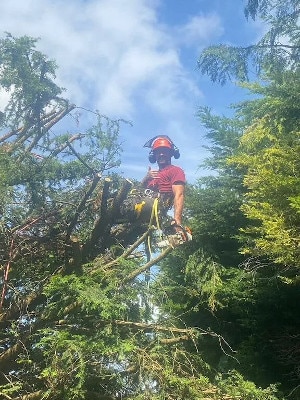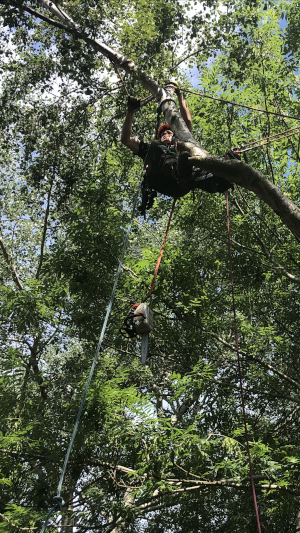Crown Reduction Chepstow
Fully Insured And Qualified Arborists
Crown reduction is not merely about cutting back branches; it’s about ensuring the future health and stability of the tree. By removing excess weight from the ends of branches, the technique helps to prevent limb breakage, which can be caused by high winds, snow, or ice. It also allows for increased sunlight penetration and air circulation within the canopy, which can reduce the likelihood of disease.
What is Crown Reduction?
Crown reduction is a specialised tree pruning technique aimed at decreasing the height and/or spread of a tree’s crown. This method involves carefully removing the tree’s outer branches to a suitable growth point, ensuring the overall shape and structural integrity of the tree are maintained. Unlike other pruning methods, crown reduction is specifically designed to make significant alterations to a tree’s size without harming its health or growth potential.
The Process Explained
The process of crown reduction is meticulous and requires a deep understanding of tree biology. Arborists performing crown reduction select and remove terminal branches and larger limbs to reduce the tree’s height and spread. Each cut is made with precision to avoid damaging the tree’s main structure and to encourage the tree to heal quickly. The goal is to leave behind a smaller, healthier tree that closely resembles its natural form.
Objectives of Crown Reduction:
- To reduce risk: Overgrown trees can pose significant risks to property and people, especially if limbs extend over buildings or public spaces. Crown reduction can mitigate these dangers by reducing the tree's overall size and weight.
- To manage health: For trees that are diseased or have suffered storm damage, crown reduction can remove affected limbs to prevent further decay and promote recovery.
- To enhance aesthetics: In urban and landscaped environments, crown reduction can help maintain a tree's shape and appearance, ensuring it complements its surroundings without overshadowing or obstructing views.
- To stimulate growth: By removing older, potentially unproductive branches, crown reduction can encourage the development of new growth, revitalising a tree and improving its vigour.
Crown Reduction vs. Other Pruning Techniques
It’s important to distinguish crown reduction from other pruning practices like topping and thinning:
Topping involves cutting large branches or the tree’s top to stubs, which can severely harm the tree’s health and structural integrity. It is considered a harmful practice and is generally discouraged by arboriculture professionals.
Thinning, on the other hand, removes select branches throughout the crown to improve light penetration and air movement without significantly altering the tree’s size or shape.



The Benefits of Professional Crown Reduction
Using a professional tree surgeon for crown reduction services brings a host of benefits, ensuring that trees are not only aesthetically pleasing but also healthy and structurally sound. Here’s a closer look at the advantages of opting for professional crown reduction.
Enhanced Tree Health and Longevity
Professional crown reduction is pivotal in promoting tree health and prolonging its lifespan. By removing diseased, damaged, or dead branches, tree surgeons help prevent the spread of decay and disease. This targeted pruning encourages healthier growth patterns and improves the overall vigour of the tree, enabling it to live a longer, more robust life.
Improved Safety
Overgrown or damaged trees can pose significant safety risks, particularly in residential areas or near public infrastructure. Limbs that overhang buildings, walkways, or power lines are accidents waiting to happen, especially during severe weather conditions. Professional crown reduction mitigates these risks by carefully balancing the tree’s size and shape, thereby reducing the likelihood of property damage or personal injury.
Aesthetic Appeal
Trees are integral to the landscape’s visual appeal, and their management should enhance their beauty without compromising their health. Professional arborists possess the skill to shape trees in a way that complements the surrounding landscape, ensuring that crown reduction contributes positively to the overall aesthetic of an area. A well-executed crown reduction can transform an overgrown tree into a striking landscape feature.
Disease Prevention
Crowded branches can inhibit airflow and light penetration within the tree’s canopy, creating conditions that are ripe for the development of fungal diseases and pest infestations. Professional crown reduction helps to open up the canopy, improving air circulation and sunlight exposure. This not only deters pests but also promotes a healthier, more resilient tree.
Stimulation of New Growth
Selective pruning during crown reduction can stimulate new growth in trees. By removing older, potentially less productive branches, tree surgeons can encourage the development of new branches and foliage. This rejuvenation process can enhance fruit production in fruit-bearing trees and improve the overall appearance and health of ornamental trees.
Preservation of Tree Structure and Stability
Our team approach crown reduction with an understanding of tree physiology, ensuring that cuts are made in a way that preserves the tree’s natural structure and stability. This careful approach prevents the development of weak spots that could lead to future breakages, maintaining the tree’s structural integrity over time.
Expertise and Equipment
Our tree surgeons are equipped with the knowledge, skills, and specialised equipment necessary for safe and effective crown reduction. They understand the unique needs of different tree species and can tailor their approach accordingly. Moreover, their expertise ensures that all work is carried out in compliance with local regulations and safety standards.
Crown reduction is a pruning technique used to decrease the height and/or spread of a tree’s crown. This is achieved by carefully removing the ends of branches, ensuring the tree maintains a natural appearance and its health is not compromised. The process is distinct from other pruning methods, such as topping, which can harm the tree.
The timing for crown reduction can vary depending on the species of the tree and the specific reason for the reduction. Generally, late winter or early spring, when trees are dormant, is considered an ideal time as it minimises stress on the tree. However, emergency situations, such as post-storm damage, might necessitate immediate action regardless of the season.
The frequency of crown reduction depends on the growth rate and health of the tree, as well as the objectives of the pruning. Some trees may require only occasional reduction to remove dead or diseased wood, while others might need more regular maintenance to manage their size and shape. Consulting with a professional tree surgeon can help determine an appropriate schedule.
When performed correctly by qualified professionals, crown reduction is safe and can be beneficial for the tree. It can improve the tree’s health by removing unhealthy branches, reduce the risk of branch failure by lessening the load on larger limbs, and stimulate new growth. Incorrect pruning, however, can cause significant harm, which is why professional expertise is crucial.
Professional crown reduction, aimed at maintaining or improving tree health, should not adversely affect a tree’s lifespan. On the contrary, by removing potential hazards and promoting a stronger structure, it can help prolong the tree’s life. Incorrect pruning practices, like topping, can significantly shorten a tree’s lifespan and are not recommended.
Crown reduction is a complex process that requires an understanding of tree biology, proper pruning techniques, and safety procedures. While minor pruning can sometimes be undertaken by the tree owner, crown reduction is best left to professional arborists. This ensures the health of the tree is not jeopardised, and personal safety is maintained.
In some cases, especially if the tree is subject to a Tree Preservation Order (TPO) or located within a Conservation Area, you may need permission from your local council before undertaking crown reduction. It’s essential to check with local authorities to ensure compliance with regulations and avoid potential fines.
Other areas near Chepstow we cover includes:
© 2021 D & B Tree Services Ltd | Privacy Policy | Home
Other locations we cover include: Monmouth, Newport, Cwmbrân
